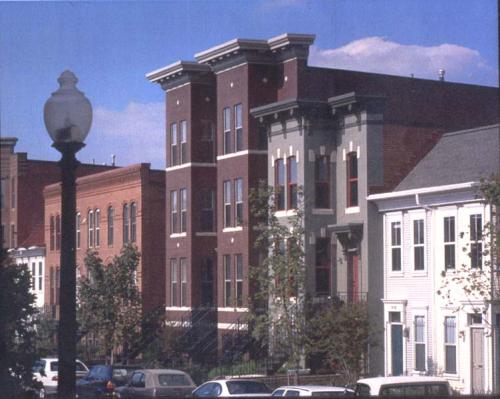
Townhomes on Capitol Hill
Location: Washington, D.C., United States. Mixed-Income Community
Townhomes on Capitol Hill
Some of the most innovative applications of New Urbanist principles are exemplified in mixed-income infill developments. The Townhomes on Capitol Hill, funded by the federal government’s HOPE VI program, creates a truly integrated neighborhood, helps low-income households build their wealth, and complements the architecture of a historic city.
The 134 units of housing in the Townhomes are on a 5.3-acre site in the District of Columbia. Of the Victorian-style units, 34 are reserved for households below 25% of area median income, 33 units for households between 25% and 50% of median, and 6 units for households between 50% and 115% of median. Residents are homeowners in a cooperative; each household purchases a cooperative share and earns equity in proportion to household income. Every unit is constructed with the same materials and finishes, and families with different incomes are evenly distributed throughout the site.
The historic surrounding Capitol Hill neighborhood inspired a wide range of facade designs in the townhomes, despite floor-plan similarities. Facades vary in height from two to four stories and include a broad palette of finishes. In addition to facade variations, units have eleven different plans ranging in size from one to three bedrooms.
New streets were created to provide each dwelling unit with a front door opening to a public street. This design acknowledges the street as the most important setting for community interaction. Both new streets connect to the grid at either end, providing public safety by encouraging through-traffic and activity. In addition to street parking, the project provides parking behind the units, reached from the alleys.
Ellen Wilson Place, a new, small one-way street modeled on historic minor streets through large Capitol Hill blocks, is placed to allow new infill housing on 6th and 7th Streets alongside existing houses. Ellen Wilson Place is tightly developed with street trees shading parallel parking areas and relatively shallow house lots. A mews building type was developed to provide private side yards in lieu of rear yards and side front entry to allow a sense of private separation from the narrow public sidewalk.
In addition to innovative design concepts, the redevelopment included significant community involvement. In 1991, a group of neighborhood residents organized a community development corporation and subsequently partnered with the development team.
The initiative included a pre-apprenticeship training program for 50 neighborhood residents. The eight-week program taught the basics of construction trades along with life skills and math and reading skills. All trainees were employed by subcontractors during construction, and many went on to be hired as full-time employees.
Aside from a $25 million HOPE VI grant from the Department of Housing and Urban Development, the Townhomes require no ongoing public housing operating subsidies. Resident housing payments to the cooperative cover all operating expenses.
Today, the development is a vibrant, mixed-income, racially and socially integrated community. The project conveys a positive multifamily housing image and demonstrates to others that troubled public housing sites can be successfully redeveloped as viable mixed-income communities if properly designed, constructed, marketed, and managed. The project is a national model of how communities and developers can work together to create feasible affordable housing that not only meets, but exceeds, the social and architectural expectations of the surrounding community.
Transect Zone(s): T4 general, SD district.
Status: <Unknown>
Project or Plan's Scale: Neighborhood
Land area (in acres): 5
Total built area (in sq. ft.):
Total project cost (in local currency):
Retail area (in sq. ft.):
Office area (in sq. ft.):
Industrial area (in sq. ft.):
Number of hotel units:
Number of residential units (include live/work):
Parks & green space (in acres):
Project team designers: Weinstein Associates Architects
Project team developers: Telesis Corporation, Ellen Wilson Neighborhood Redevelopment Corporation
Previous site status:
Starting/Ending date of construction/implementation: -




